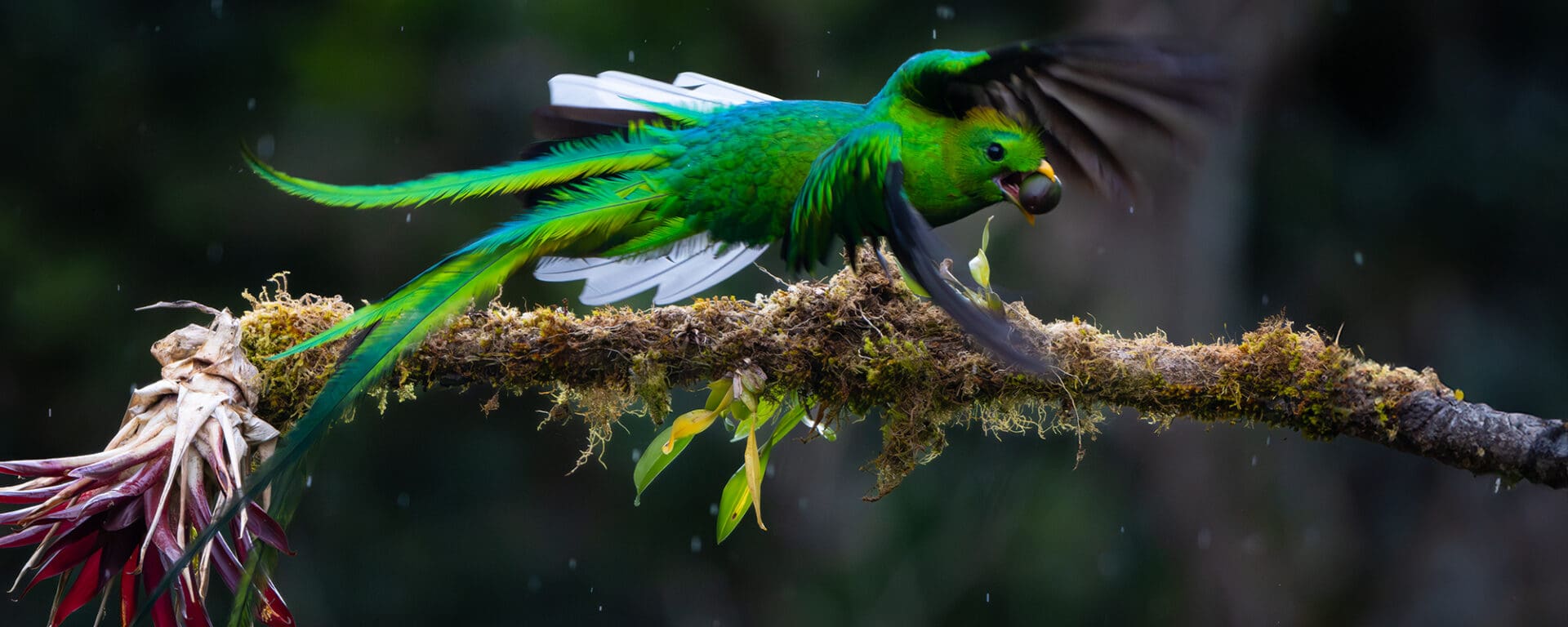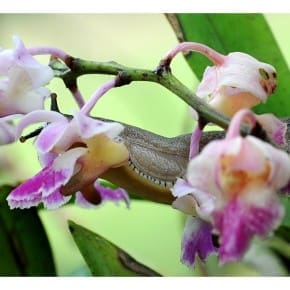Recap: In part 5 of the Costa Rica birding diary, we spent a morning enjoying a surfeit of toucans and getting a taste of urban street life. But the best is yet to come.
The time is 4:45 AM. We stumble groggily out of our hotel rooms. It is pitch dark outside at Suenos el Bosque and the sounds of tropical life forms going about their night-life are all-pervading. Murukesh, Subha, Pranav, and I pile into the Toyota van and are greeted by a fresh-looking Orlando. Today is the most anticipated day of the trip and marks the final structured day of our seven-day birding tour in Costa Rica. We are seeking a glimpse of the Resplendent Quetzal (Pharomachrus mocinno), a strikingly handsome bird that the ancient Aztecs had associated with a feathered serpentine deity, Quetzalcoatl.
If you have ever seen a photograph of this bird, you would have no difficulty relating to the imagination of the ancient Aztecs. Adult males have long, iridescent green upper tail feathers that grow almost as long as the bird, often longer. The spectacle of this bird in flight is poetry and magic in equal measure, as the tail plumes flail and then flow in the bird’s wake, almost like a sidewinder on the desert sands. When we had planned this trip, the Resplendent Quetzal was the Number One bird on our wish-list. Over the years, I’ve watched pictures that my friends and other photographers made, struggling to control the seething envy.
Inside the car, the group’s excitement is palpable. We are on a quest equivalent to the holy grail for first-time birders in Costa Rica. We all know that how this day goes will significantly bear upon how we look back at this trip a month, a year, or a lifetime later. It is to be seen whether this trip would end up being an all-out immersion in the Costa Rican avian magic show or end up as an “if only” memory.
We are to be at the entry point to the Quetzal Tour at 6 AM sharp so we can get a glimpse of the bird’s early morning activity. Our lodge is nestled deep within a valley. Getting in and out is an adrenaline trip, the road being terrifyingly steep and badly paved; in fact, it finds a mention in most reviews of the lodge. Our 63-year-old driver nonchalantly navigates the steep gradient and the corkscrewing trail with admirable dexterity. That so many resorts operate in this deep gorge indicates how sought-after the quetzals are among birders and regular tourists alike. It is also evident that the Resplendent Quetzal is the prime mover for the economy in these parts, as every lodge tips its hat to the bird in some way, either by a reference to its name or in their insignia.
These mountains are one of the few places in the world where the Resplendent Quetzal thrives, thanks to its stunning biodiversity and ongoing conservation efforts. The bird is classified as Near Threatened (NT) on the IUCN Red List and some of the revenue from tourism is helping conservation efforts. The quetzal’s primary source of nutrition is a kind of wild avocado that grows in these parts. These fruits are just about the size of the pits of the commercially available ones and turn purple-black when they ripen.
Even though the sun has risen, it is dark here in the mountains. We pull off the mountain highway and Orlando is grateful that there aren’t many trucks. He says, in his broken English accompanied with vigorous gesticulations, that the climb up from the valley to the highway usually gets doubly hard if the trucks carrying supplies to the valley are going downhill at the same time. It is not hard to imagine.
After almost an hour’s drive, we pull over. A good-looking young man introduces himself as our guide. David points us toward the farm where we are to wait for the Quetzal to feed. Surprisingly, his English is extremely fluent; he is the first guide we meet in Costa Rica who is comfortable with the language. We follow him down another valley, and the road here makes the one we took to the resort seem like a smooth glide over an ice rink. If that one descended from the main road rapidly, this one appears to be plummeting into an abyss and is mostly unpaved. Once again, Orlando is unruffled and navigates the steep decline without breaking a sweat. Our ears pop as we pull up at the farm’s entrance, which the quetzals are known to frequent. Just outside the farm is a small house with a pickup truck parked outside, and a black dog sits at its threshold, eyeing us suspiciously. We see a few other photographers getting out of two parked cars, and we wave at them.
We realize the farm is lying fallow, as there appears to be no cultivation. It is dotted with wild trees and clumps of wildflowers planted to promote the local ecology. Past the gate, we notice that we must negotiate a steep climb on foot: a tiny dirt trail runs up the slope, portions of which are stabilized into makeshift steps using wooden planks. The steep climb with our heavy gear has us winded but thankfully, our destination is soon in sight. It is a small shack with a patio in front, a quaint little kitchen, and two spotlessly clean washrooms in the back. The group that got there before us is already setting up their tripods. It consists of Dennis, a Costa Rican who lives in Canada, photography enthusiast Karin, her husband, and her teenage daughter who too seems to be dabbling in photography. We pick a spot and plant our tripods — a photographer’s equivalent of peeing on a tree to mark territory.
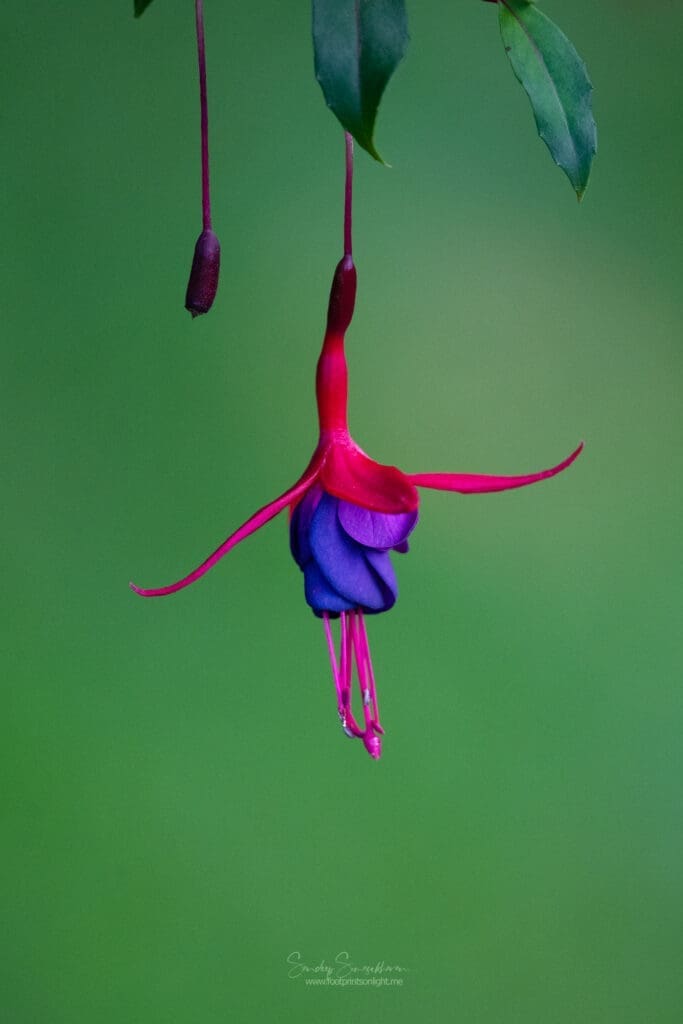
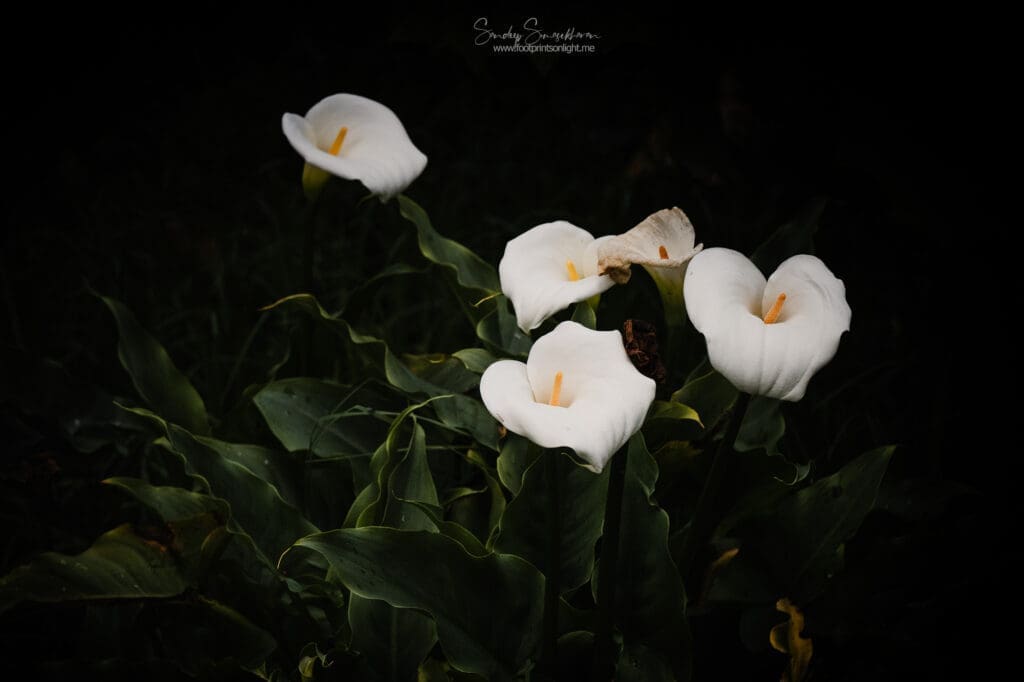
Right in front of us lies a small patch of farmland fenced off with chicken wire, which tells us that there may have been photographers in the past who got too greedy and spooked the birds by venturing too close. At the heart of this sanctum sanctorum is a magnificently sprawled avocado tree, about 15 to 20 feet tall with a very dense trunk that declares proudly that it has seen many more winters than the people around it. Its outer periphery has tiny bulbous shapes dangling from every branch — wild avocados, the stuff that quetzal dreams are made of.
As the sky brightens, a piercing call erupts from our left, amidst the wildflowers. A warbler-sized sooty bird with an oddly crooked bill sits on a conspicuous perch in the middle of pink wildflowers, belting an incessant shrill song. This is the Slaty Flowerpiercer (Diglossa plumbea), an endemic to these parts, and one on our wish-list. That ticked off, we continued watching out for the quetzals. The guide from the other party and David start preparing coffee for everyone in the kitchen. As we watch, an older gentleman who seems to be a local ambles up the slope and walks into the kitchen to join one of the guides there. The coffee is delicious and provides just the amount of warmth we have been craving.


Suddenly, there is a flutter to our right, and from behind the shack shoots out something green, red, and white. “Male quetzal,” someone remarks. It flies into the avocado tree and then comes out to perch on one of the artificially planted perches that litter the landscape. These are mostly fallen branches that still have life clinging to them in the form of mosses and epiphytes — a minor adjustment to the landscape that allows uncluttered views of the birds for tourists. David explains that these perches are sourced from trees that the quetzals prefer.
This quetzal’s head has a crest of spiny feathers that gives it an air of recently having gone through a hair-raising experience. The black beady eye and the beautiful yellow beak are consistent with the males we have seen in photographs. We crane our necks to find the long-flowing tail, but that seems conspicuously absent on this bird. “It is a juvenile male,” clarifies David. The bird perches nonchalantly for a minute and takes off.

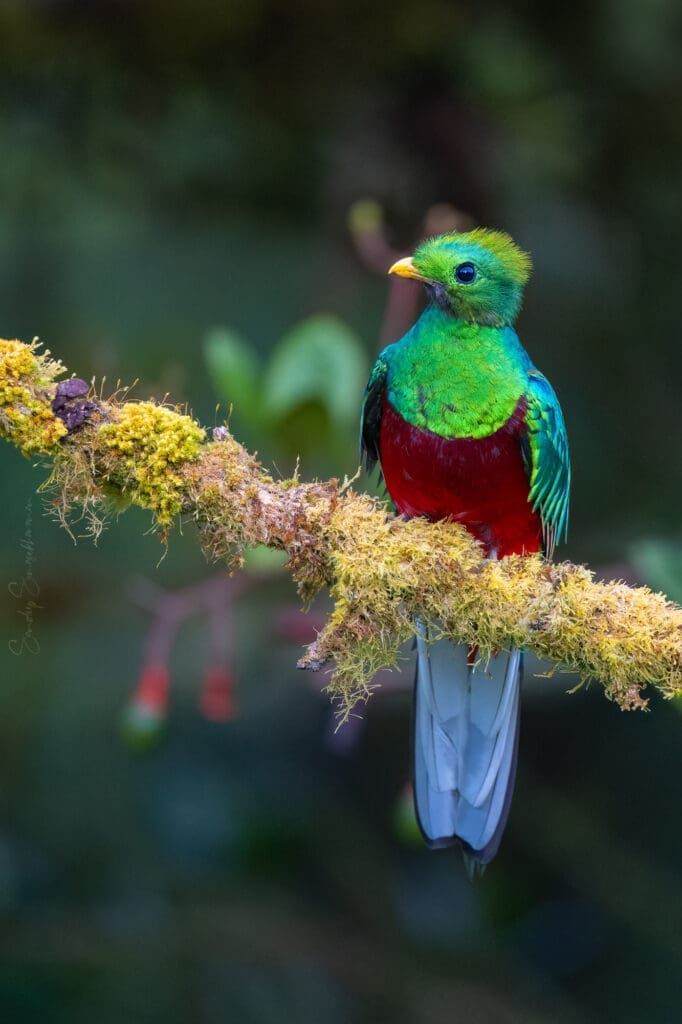
“The juveniles lack the long plumes of the adult males,” one of the guides explains in excellent English. “The adult males too do not sport the long plumes year-round. Just around the breeding season they start sprouting the long tail feathers and shed them after mating. It is an unnecessary drag to carry around perennially.”

Shortly afterward, a female presents us with some photo opportunities. It first retreats into the depths of the avocado tree, but later ventures out and chooses one of the open perches. The back is still a resplendent green, but the head is duller and the beak a drab grey. There is a trace of red in the belly, but nothing as striking as that of the male. It flies to the edge of the tree, grabs an avocado on the wing, and flutters away into the woods.
The guides are happy with the bird activity this morning, as clouds and rain are on the forecast. They tell us that the previous day was devoid of activity till 4 PM as it was bright and sunny.
“The quetzals avoid being out in the open in direct sunlight as they would stand out and could be easily preyed upon due to their iridescence,” someone explains. However, as the sunbeams illuminate the hill facing the shack, we start getting antsy. Our hunger surfaces as well, and we take out the peanut-butter sandwiches from the restaurant, and share them with David.
To one side of the shack is a small tray filled with fallen wild avocados. David splits one open for us and we see there’s barely any flesh between the skin and the pit. These avocados account for 60-70% of the quetzal’s diet in these parts. The trees fruit in intervals of four to six months and, when they are not fruiting, the quetzals go looking for other avocado trees laden with fruit.
According to the guides, the quetzals grab these and fly to where they can conveniently swallow them. However, the fruit doesn’t go down to the stomach entirely but undergoes a pitting process — one of the marvels of evolution. The quetzals have a special muscle in the throat that helps separate the pit from the flesh and skin, which is then swallowed. The bird then regurgitates the pit. This way, it doesn’t spend time in the open and is less susceptible to predation.
There’s another group climbing up the hill and we see them pausing and pointing the cameras at something. One of the guides who had walked downhill frantically gestures toward us to go down to where they were standing. Pranav takes off and I follow close behind. Pranav gets there a few seconds early and I can see him shoot this gorgeous male quetzal on an open perch. I lift my camera and fire away, but the bird takes off that instant, away from the camera. The bird perches high up on one of the trees, and all around me are people celebrating the shots they got. I return to the cabin with the air of someone whose parade had been rained upon.
We shift our attention towards the other birds. A pair of Yellow-thighed Brushfinches (Pselliophorus tibialis) hop around and perch in nightmarish spots, not giving us good shots. A Collared Redstart (Myioborus torquatus) shows up and entertains us briefly. A family of Spotted Wood-quails (Odontophorus guttatus) ambles about without a care in the world. None of that can allay the deep feeling of loss that is permeating into my essence.
What if that was the only chance I got at a male? I can see Murukesh is also wrestling with the same thought process. Soon, it is mid-day and we start walking around to see if we can find something else. Someone points to a bush and I notice another incredible bird on top of it. Its head is crested like a cardinal’s but it is yellow in color. The body is a slaty gray, and the long tail twitches ever so slightly while the bird tries to balance itself against the wind.
Pabro, another guide who turned up with a new group, identifies it for us. It is a Long-tailed Silky Flycatcher (Ptiliogonys caudatus). And once it too takes off, the place wears a deserted look. Most of the families and tour parties that turned up at the shack are heading back, giving up hopes of finding a male quetzal.
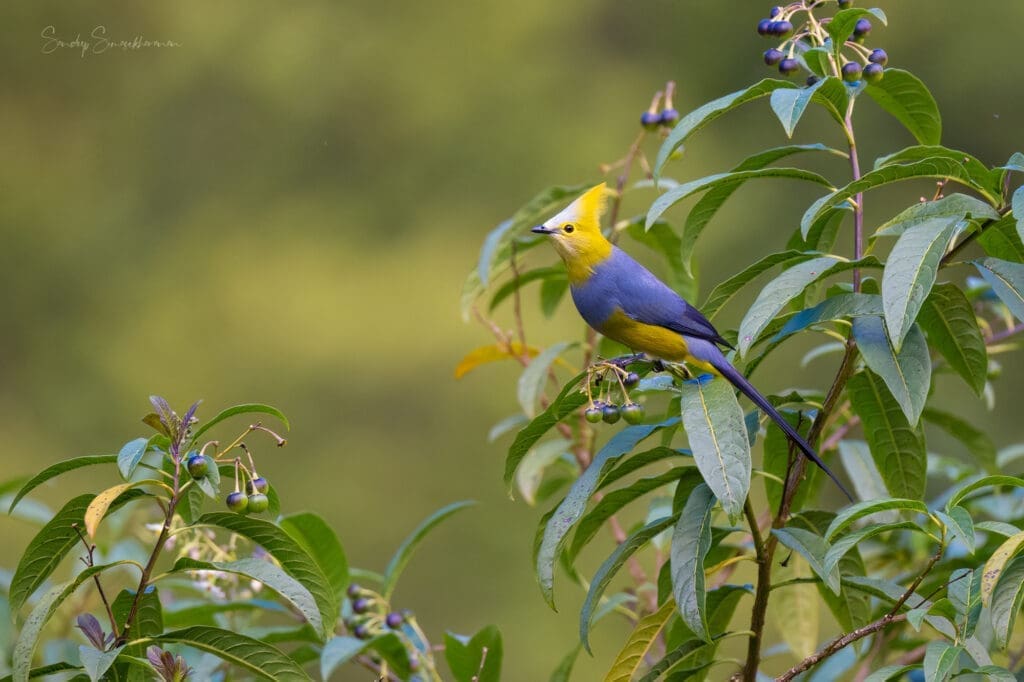

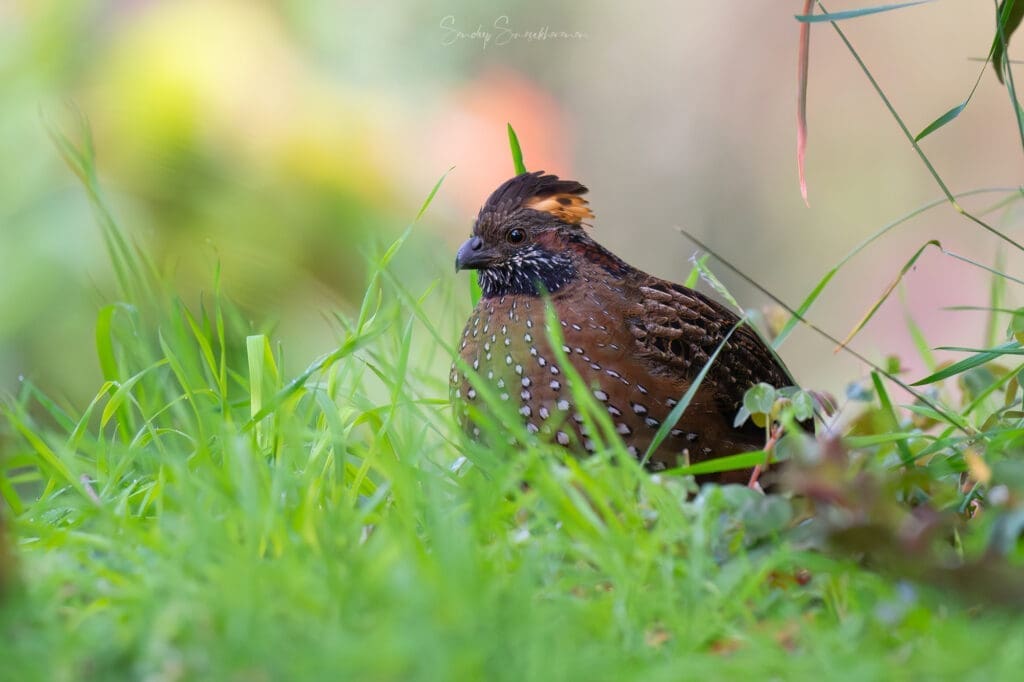
David tells us that the place would be closed for lunch soon, and suggests we get lunch at Paraiso Quetzal Lodge and return by 2:30 PM. Reluctantly, we head out, and Orlando drives us to the lodge. It has a nice deck, but we opt not to bird, so that we can be the first ones back at the observation deck. Many of the faces we had met at the shack are at the restaurant. All over the wall are quetzal photos, including some from Supreet, our tour organizer. Most conversations are about whether or not they got to see the quetzals.
The food arrives soon. It costs almost double what we had anywhere else, and tastes just okay. It is evident that the chicken I ate had a membership at a gym, as the meat feels rock solid. The dessert, however, is amazing; it consists of a circular slice of pineapple drowned in rum, topped with a dollop of vanilla ice cream. The menu said the rum would be lit on fire, but mine wasn’t. Since we were hurrying to finish off and leave, I decide against asking for a lighter.
We hurry back once we are done and climb up towards the observation deck. Soon, more people arrive, but there are not many birds. We meet Holly and her family, who are from Florida and have been traveling constantly. Their daughter has been to 55 countries in her 13 years — what a way to rear a child, we think. Karin and family are back, and so are some new folks — a French-Canadian couple, an Asian gentleman with a friend, and we all wait crammed into the shack, shoulders almost touching.
“I was here yesterday and got the bird in every possible pose,” says the Asian gentleman. “I am just back to get a shot of the bird with the avocado in the mouth.” I can’t help but notice that the place has become very noisy. Even the guides appear quite vocal. When I ask about it, they say, “The quetzals don’t care much even if we make a ruckus. We could be having a barbecue party here, they would still turn up, as long as we don’t stay out in the open.”
Every passing minute our hopes are fading. Murukesh and I contemplate if we could return the next day if we don’t get the male in the open by sundown. David tells us he is unavailable the next day and suggests we speak to the hotel and get another guide.
Around 3 PM a drizzle begins. Under the shack canopy, the mood perks up.
“The quetzals are more comfortable coming out during rains,” explains one of the guides. “The sheen created by the rain on the leaves creates a better camouflage for the birds.”
Another flutter on the left. “Male quetzal!” someone hisses.
There are the telltale long trailing plumes as a bird perches on one of the open branches. However, the head is a bland greyish green and the beak is a dull grey, consistent with a female’s. The guides look puzzled as well. They conclude that we are looking at a rare female with long tail feathers. A male finally appears too, but decides to perch underneath the avocado tree, refusing to come out. I squeeze out a shot from in between the branches. We soon lose sight of it under the canopy and assume it has left the scene.
To our left, a pair of Sooty-capped Chlorospingus (Chlorospingus pileatus) hops back and forth on the high branches. A Rufous-collared Sparrow (Zonotrichia capensis) hops from one tree to the other. A female Purple-throated Woodstar (Philodice mitchellii) flits in and out of the blossoms. The Sooty Flowerpiercer announces its presence on and off from the bush two feet away from us. The light fades further as the sunset looms closer. I tell Murukesh that I would accept that it was not meant to be and move on; I don’t plan on returning the next day. He too has resignation writ large on his face.
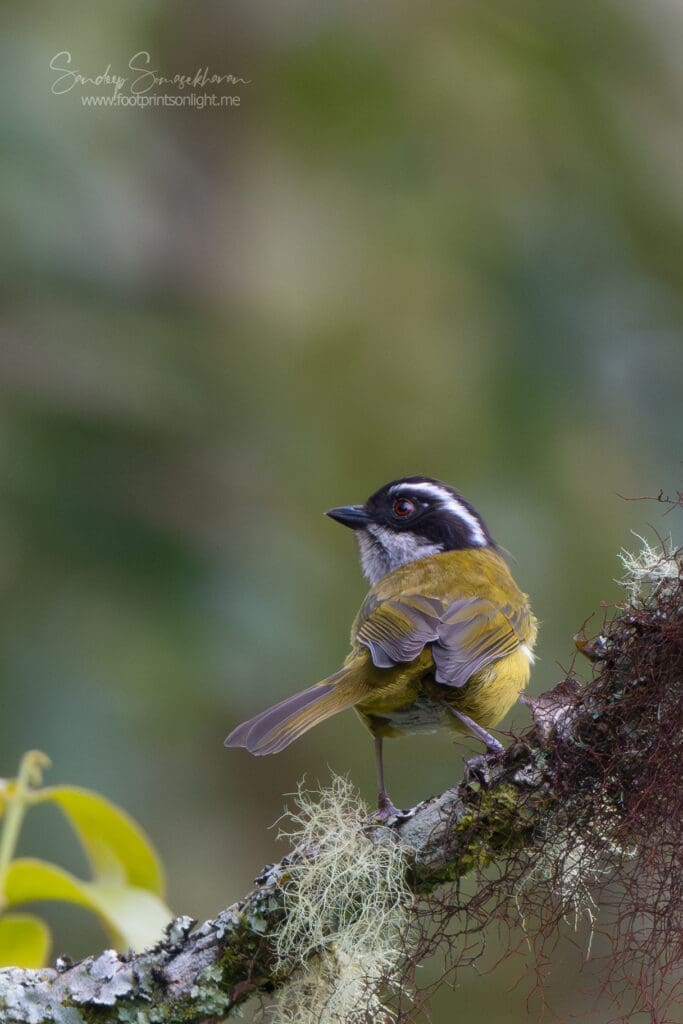
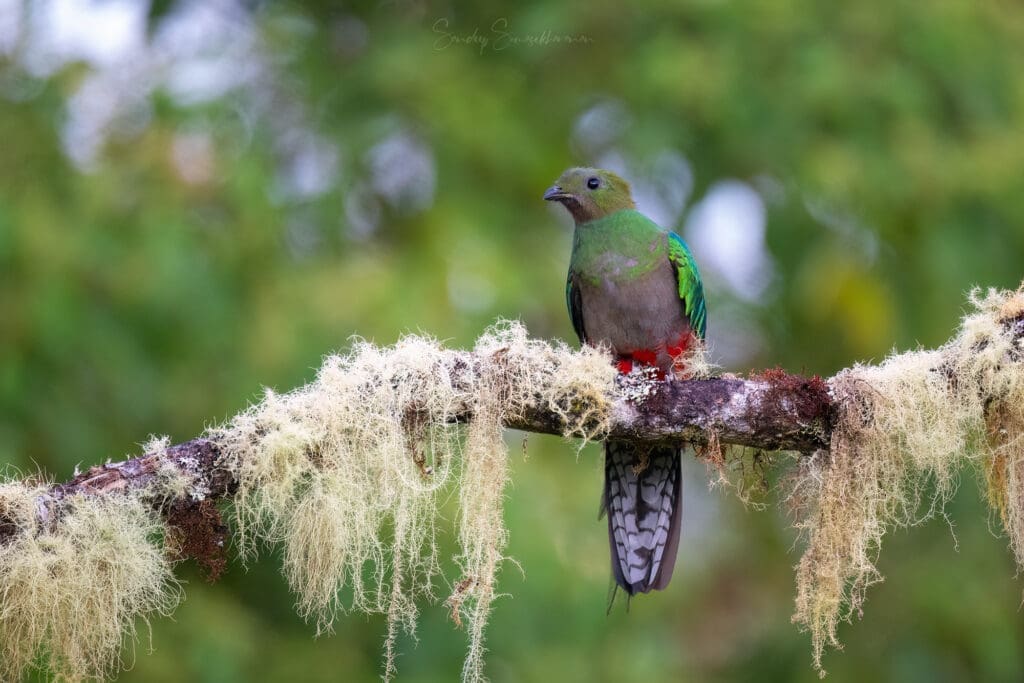
“Quetzal,” says Orlando quietly from out of the blue, looking out of the side window of the shack toward the woods on the right. It snakes gracefully through the air and lands on a perch to the right of the avocado tree. Raindrops are floating down all around, like heavens sprinkling magic. It is a gorgeous male, with a crown of golden feathers, a yellow beak, beady black eyes, and a flowing, resplendent tail.
All around us, shutters click in unison. Someone shouts to someone else, “Excuse me, you are in my way, sorry!” There is a muted apology.
The quetzal lifts off, grabs an avocado on the wing, and moves to the second perch. There it sits for a few minutes, still unhurried. Everyone fires away like they will have no use for their cameras henceforth. The female Purple-throated Woodstar is hovering at a minimum focusing distance in front of us, while everyone is transfixed, pointing cameras at the quetzal. The bird takes off, the avocado still in its mouth, and alights on the perch closest to us, its red belly towards us. It feels like an eternity as it shuffles between that and the original perch, totally unperturbed as Quetzalcoatl just granted us a boon for our penance. Finally, this magnificent bird lifts off into the woods.
The mood in the shack has changed. There are excited giggles, oohs and aahs, as people preview the images they have made, sharing their best shots. Outside, light fades rapidly.


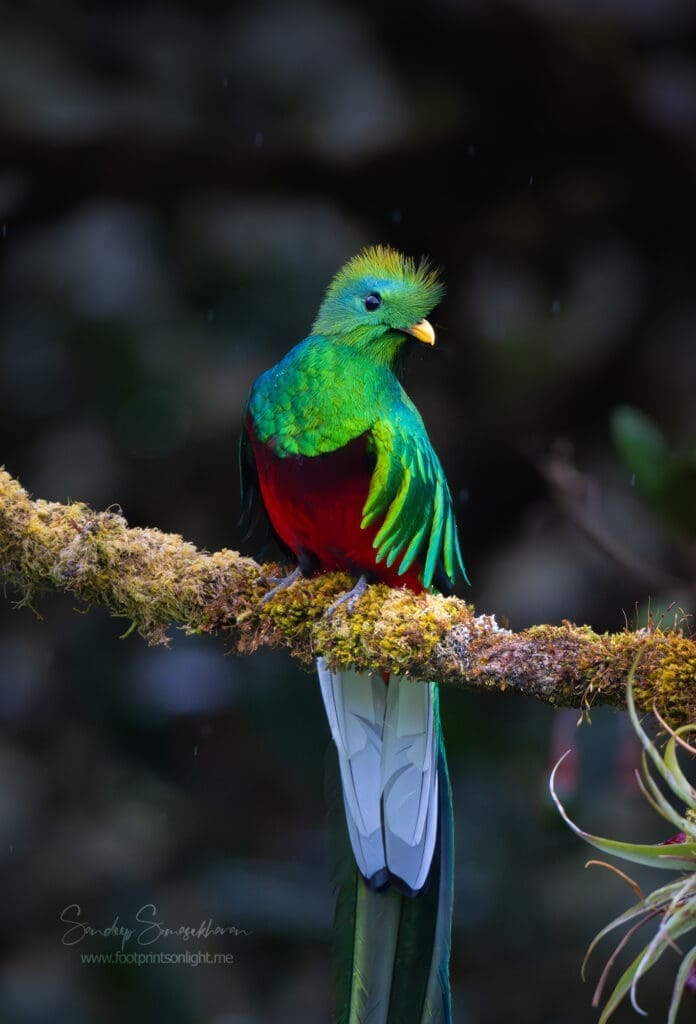

The Spotted Wood-quails have reappeared under the avocado tree. Some of us go down and I realize for the first time that they have an orange crest, displayed on and off. We snap some pictures with the guides and tip the guides as well the local man that we had seen in the morning, who is cleaning up after us. As we head down, David tells us that this unassuming guy owns the place. We are shell-shocked. Murukesh tells me: “I tipped him a tenner and he thanked me and put it in his pocket!”
Inside the van, we slip into poignant silence. This is the end of our guided tour. We have a day off tomorrow at the lodge and will head back into the city in the afternoon. Our Costa Rica experience is winding to a close, with a glorious evening spent with the most amazing bird we have seen all week. “The rain, the rain is what helped us. The quetzal never was comfortable in the open till it had rained for an hour,” says Pranav. I too can’t believe our luck. “We had seven days of birding, and the rain never once turned up. We never lost a second of birding to bad weather. This has never happened to me before, on any birding trip!” I exclaim.
“Like I said before, we are good people,” smiles Murukesh.

We pile into the Toyota. All the cars, other than David’s, have already departed. The dirt road is slick with the drizzle that had lasted two hours. Orlando floors the accelerator to get us past the first steep curve, but the wheels slip, and the engine stalls. He tries again, and the wheels are now just spinning in place. The van doesn’t budge and an inch. We offer to get out and walk to lighten the load and Orlando tells us in broken English to stay in the car. We think it is because he doesn’t want us to get wet, and insist that we get down and walk up the curve so that he could drive the van up without the load of the four of us. David too pulls up and talks to Orlando as the four of us start walking uphill. David calls us back from behind.
“Come and get in the van! He needs you in the back, so the back wheels get the traction!” Subha has already walked a little ahead so the rest of us return to the van.
David explains what Orlando’s limited vocabulary did not permit him to: “When the weight is on the rear axle, the wheels get better purchase, helping the van climb. So sit on the back seat diagonally opposite the driver’s and we should be able to pull through.”
Orlando also informs David that we may be unable to stop to pick up Subha as she is halfway up the climb. We agree that David would pick her up on his way.
David walks back to his car, and Orlando again resumes his perennial wrangle against the grade. This time the weight on the rear axle does the trick. The wheels stick this time, helping the van lumber past the curve. Orlando continues steering it further uphill, past a bewildered Subha. Murukesh shouts to her to get into David’s car, but his voice is drowned out by the engine flexing every sinew to get us out of that gorge.
We look back to see if David’s car is behind us, but we don’t see it. Pranav tries calling Subha on her cellphone, but the coverage is too patchy to get the call through. Orlando has no choice but to keep driving as the entire path is steeply uphill, and stopping again may mean another struggle for the van. To our relief, we see a car’s headlight behind the curve and keep driving. Once the gradient eases out we pull to the side and wait for David. The car that followed us pulls past us and we realize it is not David’s. Behind it, as far as the eye can see, there is no sign of any other vehicle’s headlight. Murukesh gets out of the car and starts walking back when David’s car appears around the curve. He pulls over, Subha steps out of the car, and we all heave a sigh of relief. We thank David and resume our drive back to the lodge.
Subha explains that David too drove past her because he doesn’t have a four-wheel drive. He had stopped several yards ahead, at a spot where he wouldn’t have difficulty starting again. As he walked back toward her, the other car that had passed us had stopped near Subha asking if she needed a ride. By then David too had caught up with her, and the two of them had walked back to David’s car and driven uphill.
At Suenos el Bosque, we settle down for dinner after our showers. This has been an eventful day, and the adrenaline rush from the drama at the tail end has not dissipated yet. We order dinner, and I pick chicken pasta this time. The dinner is filling but the feast at Boca Tapada has spoiled us. We are exhausted and as soon as I polish off the dessert — apple pie — we retire to our rooms. It is cold, and I pull on the blankets from the second bed too, drifting off in no time.
My dreams are all about a serpentine bird, with a ribbon-like tail snaking in the air around me.
- Costa Rica Diaries – Parting Gifts - May 5, 2024
- Costa Rica Day 6 – Resplendent Quetzal: Part Bird, Part God and Full-Time Economy Driver - April 17, 2024
- Costa Rica Day 5 – Toucan Trees and Wild Dreams Coming True - March 22, 2024

